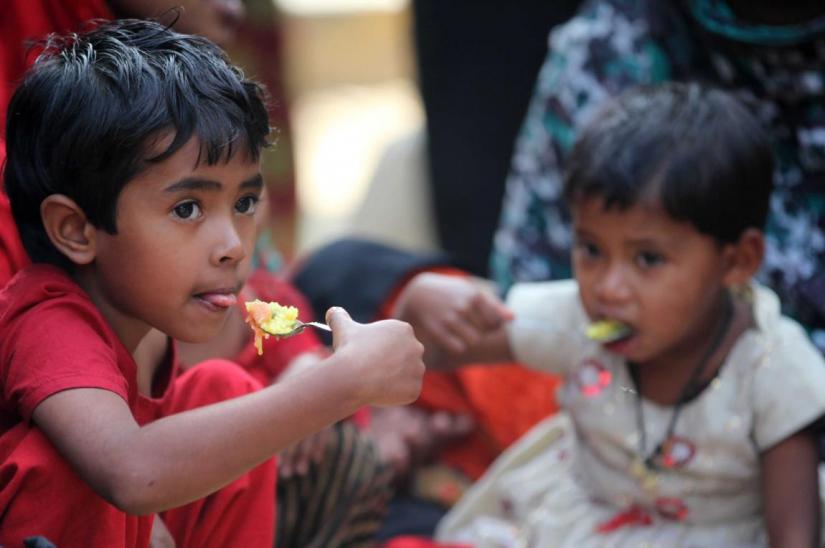 More than 45 percent of Bangladeshi children under the age of five are either undernourished or overweight and face serious health consequences, the UN children’s agency has warned in a new report.
More than 45 percent of Bangladeshi children under the age of five are either undernourished or overweight and face serious health consequences, the UN children’s agency has warned in a new report.
Globally a third of nearly 700 million children in the same age group face a similar crisis while the numbers in South Asia are one in two. India tops the chart with 54 percent of its children under the age of five facing malnutrition.
While poverty, urbanisation and modern diets that are frequently high in sugar and fat have been blamed for these alarming numbers globally, climate change has been listed as a major threat to child nutrition in Bangladesh.
“Over 19 million children spread across Bangladesh are at the front line of climate change disasters.” says the report.
It says floods and riverbank erosion are driving families to city slums, where they face overcrowding and a lack of access to adequate health and nutrition services, and adequate nutritious food.
Extreme climatic events such as drought and flash floods cause severe agricultural losses and the reduced production also leads to an increase in food prices, hitting the poorest families the hardest.
The report says Bangladesh will begin the second phase of its Climate Change Strategy and Action Plan this year.
The strategy places greater emphasis on the needs of the poorest and most vulnerable and put more resources to ensure that child nutrition, health, education, social protection, and other services are shielded from the effects of climate change.
The report, the first State of the World's Children since 1999, says globally poor children are carrying the greatest burden of all forms of malnutrition.
"Despite all the technological, cultural and social advances of the past few decades, we have lost sight of this most basic fact: If children eat poorly, they live poorly," says Unicef Executive Director Henrietta Fore.
The report says, “millions are eating too little of what they need and millions are eating too much of what they don’t need: poor diets are now the main risk factor for the global burden of disease”.
The UN agency warns that without enough diversity in children's diets, they may not get enough nutrients to grow well, which can take a devastating toll on their bodies and brains.
In 2018, 149 million children under 5 were stunted (short stature for age) and almost 50 million were wasted (low weight for height). In South Asia, 58.7 million children under 5 were stunted and 25.9 million were wasted.
The survival and physical and cognitive development of children is threatened by what Unicef described as “a triple burden of malnutrition”, a combination of undernutrition, hidden hunger from nutrient deficiencies, and obesity among children under five.
“An increasing number of children and young people are surviving, but far too few are thriving because of malnutrition,” the agency said.
 National
National
30906 hour(s) 21 minute(s) ago ;
Afternoon 01:16 ; Friday ; Apr 26, 2024
Climate change threatens child nutrition in Bangladesh
Send
Brajesh Upadhyay, Washington
Published : 11:10, Oct 16, 2019 | Updated : 11:10, Oct 16, 2019
Published : 11:10, Oct 16, 2019 | Updated : 11:10, Oct 16, 2019
0 ...0 ...
/pdn/
Topics: Top Stories
- KOICA donates medical supplies to BSMMU
- 5 more flights to take back British nationals to London
- Covid19: Rajarbagh, Mohammadpur worst affected
- Momen joins UN solidarity song over COVID-19 combat
- Covid-19: OIC to hold special meeting
- WFP begins food distribution in Cox’s Bazar
- WFP begins food distribution in Cox’s Bazar
- 290 return home to Australia
- Third charter flight for US citizens to return home
- Dhaka proposes to postpone D8 Summit
Unauthorized use of news, image, information, etc published by Bangla Tribune is punishable by copyright law. Appropriate legal steps will be taken by the management against any person or body that infringes those laws.
Bangla Tribune is one of the most revered online newspapers in Bangladesh, due to its reputation of neutral coverage and incisive analysis.
F R Tower, 8/C Panthapath, Shukrabad, Dhaka-1207 | Phone: 58151324; 58151326, Fax: 58151329 | Mob: 01730794527, 01730794528


